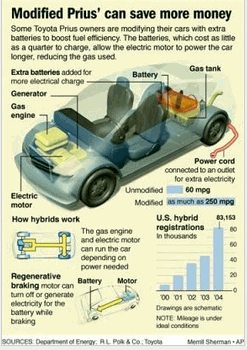 Yahoo! News reported Politicians and automakers say a car that can both reduce greenhouse gases and free America from its reliance on foreign oil is years or even decades away. Ron Gremban says such a car is parked in his garage. It looks like a typical Toyota Prius hybrid, but in the trunk sits an 80-miles-per-gallon secret — a stack of 18 brick-sized batteries that boosts the car's high mileage with an extra electrical charge so it can burn even less fuel.
Yahoo! News reported Politicians and automakers say a car that can both reduce greenhouse gases and free America from its reliance on foreign oil is years or even decades away. Ron Gremban says such a car is parked in his garage. It looks like a typical Toyota Prius hybrid, but in the trunk sits an 80-miles-per-gallon secret — a stack of 18 brick-sized batteries that boosts the car's high mileage with an extra electrical charge so it can burn even less fuel.
But what if he wants to put something else in his trunk - like luggage, or the groceries?Gremban, an electrical engineer and committed environmentalist, spent several months and $3,000 tinkering with his car. Like all hybrids, his Prius increases fuel efficiency by harnessing small amounts of electricity generated during braking and coasting. The extra batteries let him store extra power by plugging the car into a wall outlet at his home in this San Francisco suburb — all for about a quarter.
It might be a solution for in-city driving, but I doubt it will work for commuters that must drive very far, or taking a trip on vacation.He's part of a small but growing movement. "Plug-in" hybrids aren't yet cost-efficient, but some of the dozen known experimental models have gotten up to 250 mpg. They have support not only from environmentalists but also from conservative foreign policy hawks who insist Americans fuel terrorism through their gas guzzling. And while the technology has existed for three decades, automakers are beginning to take notice, too. The extra batteries let Gremban drive for 20 miles with a 50-50 mix of gas and electricity. Even after the car runs out of power from the batteries and switches to the standard hybrid mode, it gets the typical Prius fuel efficiency of around 45 mpg. As long as Gremban doesn't drive too far in a day, he says, he gets 80 mpg. "The value of plug-in hybrids is they can dramatically reduce gasoline usage for the first few miles every day," Gremban said. "The average for people's usage of a car is somewhere around 30 to 40 miles per day. During that kind of driving, the plug-in hybrid can make a dramatic difference." Backers of plug-in hybrids acknowledge that the electricity to boost their cars generally comes from fossil fuels that create greenhouse gases, but they say that process still produces far less pollution than oil. They also note that electricity could be generated cleanly from solar power.
I don't think he is going to get anywhere near enough from Solar Power, solar powered homes still need a connection to the Electric Company for backup, but nuclear power is a viable solution, if we can get past the environmental lawyers fighting the idea of new nuclear plants, and can get the Yucca Mountain storage facility activated.Paul @Wizbang blogged The AP is doing its best to spread the ever growing "250mpg hybrid" myth. Back during the first gas crunch the stories were everywhere that someone had developed a carburetor that would give 500mpg but the greedy oil companies killed him [bought him out etc] and refused to let the technology come to market. Even respected publications like Popular Science and Popular Mechanics hinted that this technology was out there "somewhere."
Fast forward to the preset gas crunch and the AP is running wild headlines and downright bogus infographics. Ok so Mr. Gremban spent an extra $4000 or so on his car, then an ADDITIONAL $3000 tinkering and he is getting a whopping 80mpg -- IF he doesn't drive real far. That's not quite the 250mpg the inforgraphic described.
James Joyner blogged This is hardly a practical solution for a family vacation but would meet the needs of most commuters. One suspects that continued high prices for gasoline would make mass marketing Gremban's technology economically feasible.




No comments:
Post a Comment